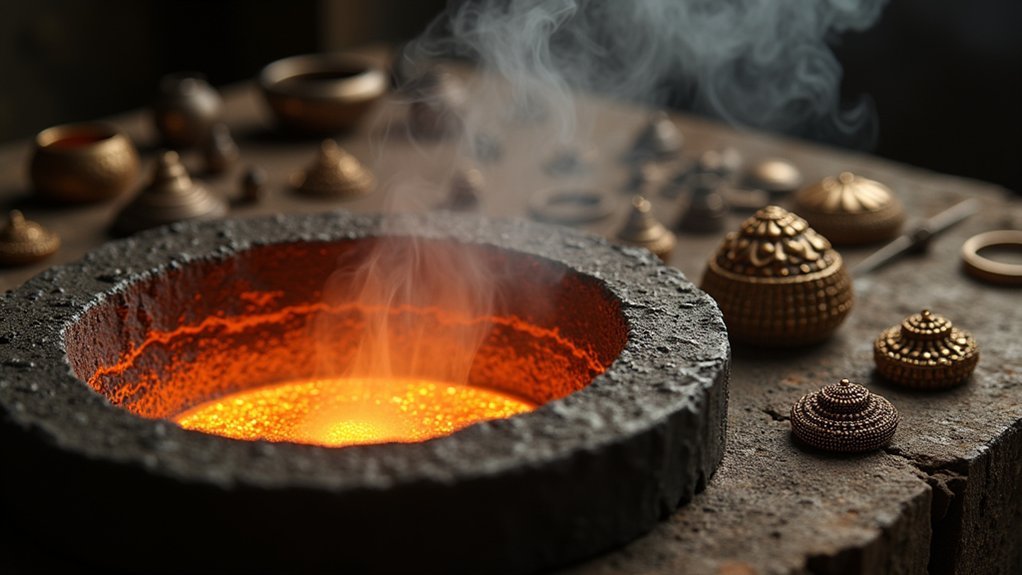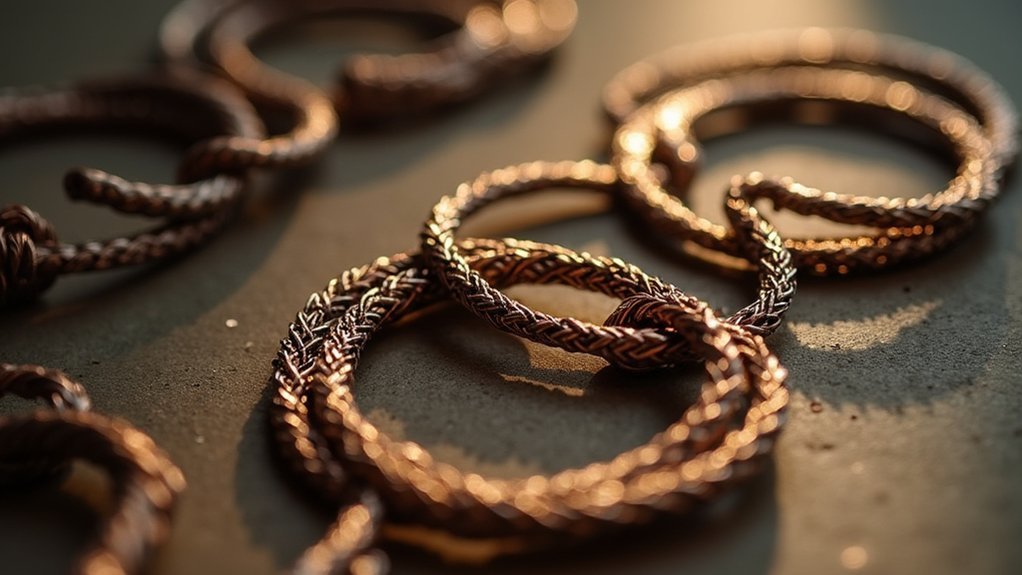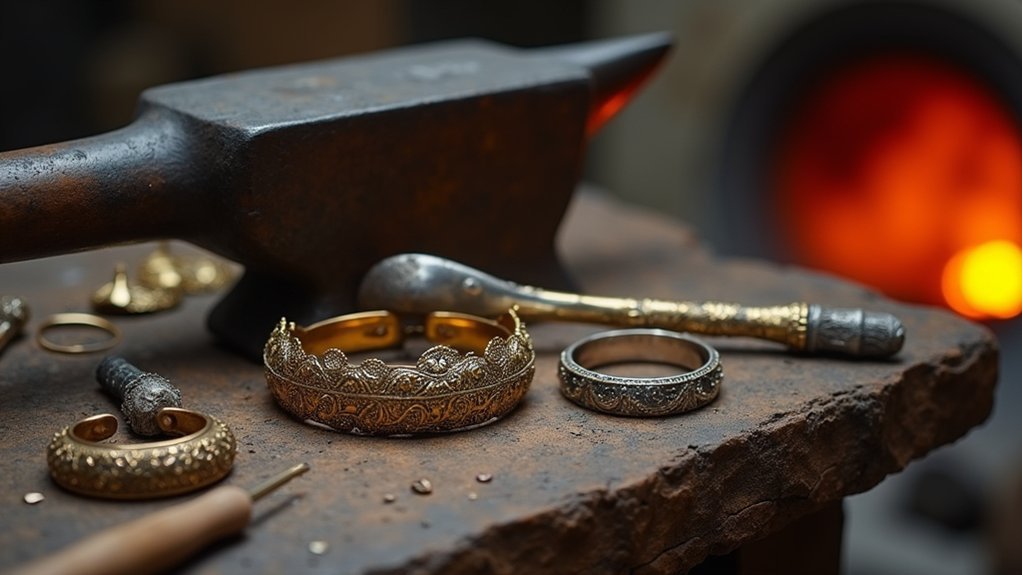You’ll find that Iron Age craftsmen perfected three essential jewelry forging methods that revolutionized metalwork. Lost wax casting allowed you to create intricate designs by sculpting wax models, encasing them in molds, then melting the wax to form cavities for molten metal. Repoussé hammering enabled detailed relief patterns by working metal from the reverse side. Wire drawing and twisted metal construction provided both strength and decorative appeal for torcs and bracelets. These techniques reveal fascinating insights into ancient craftsmanship.
Lost Wax Casting for Complex Metal Forms

When you examine Iron Age jewelry’s most sophisticated pieces, you’ll discover that lost wax casting enabled artisans to achieve remarkable complexity in their metalwork.
This ancient technique, dating back to 3500 BC, revolutionized jewelry making by allowing craftsmen to create intricate jewelry designs impossible through traditional forging methods.
You’d sculpt your desired piece in wax, encase it in a mold, then melt away the wax to create cavities for pouring molten metal. This process let Iron Age artisans craft elaborate torcs and decorative items with fine details that showcased their advanced skills with precious metals.
The technique required precise temperature control to prevent mold failure and guarantee proper metal flow.
Through lost wax casting, you could produce unique handcrafted jewelry pieces that demonstrated exceptional artistry and technical mastery.
Repoussé Hammering and Relief Shaping
While lost wax casting produced hollow forms and intricate three-dimensional pieces, Iron Age artisans also mastered repoussé hammering to create stunning relief patterns on flat metal surfaces.
You’ll find this metalworking technique involves hammering from the reverse side of metal sheets, allowing intricate designs to emerge on the front. You’d need specialized tools like rounded hammers and anvils to manipulate metal without tearing or excessive thinning.
Starting with flat sheets, you’d progressively hammer and shape them, often incorporating annealing to maintain malleability.
Celtic torcs exemplify this superior craftsmanship and artistic expression. The resulting Iron Age jewelry showcased deep, complex patterns reflecting cultural motifs and sophisticated artistic styles of the era.
Wire Drawing and Twisted Metal Construction

Beyond surface decoration techniques, Iron Age artisans developed sophisticated wire drawing methods that revolutionized jewelry construction. You’ll find these craftsmen pulled metal through progressively smaller dies, creating uniform wires essential for intricate jewelry designs. They’d use drawplates to refine diameter and profile, achieving desired aesthetics in fine jewelry.
| Technique | Purpose | Application |
|---|---|---|
| Wire Drawing | Create uniform diameter | Base wire production |
| Twisted Metal Construction | Enhance strength/decoration | Torcs and bracelets |
| Multiple Strand Twisting | Add flexibility | Elaborate hair ornaments |
| Die Progression | Refine wire profile | Complex jewelry pieces |
| Drawplate Use | Control wire dimensions | Precision crafting |
You’d combine wire drawing with twisted metal construction techniques for both functional and decorative purposes. This approach provided flexibility and durability while creating visually striking patterns in neck rings, bracelets, and elaborate hair accessories across various Iron Age cultures.
Frequently Asked Questions
What Techniques Were Used in Medieval Jewelry Making?
You’d use soldering to join metal components, lost wax casting for complex shapes, filigree with fine threads, enameling like cloisonné for color, and engraving with niello for contrast in medieval jewelry.
How Did Ancient People Make Jewelry?
You’d craft jewelry using lost wax casting, granulation with small metal beads, soldering to join metals, filigree with twisted wires, and enameling to add vibrant colors through glass fusion techniques.
What Were the Most Common Techniques and Processes Used to Create Jewellery Items?
You’d create jewelry through casting molten metal into molds, forging heated metal with hammers, soldering pieces together, drawing wire for intricate designs, and applying colorful enamels using champlevé techniques.
What Is an Iron Age Torque?
You’d recognize an Iron Age torque as a twisted metal neck ring with open ends, typically made from gold, bronze, or silver. You’d wear it as a status symbol, with its distinctive terminals often featuring decorative elements.
In Summary
You’ve now learned the three fundamental iron age jewelry forging techniques that’ll transform your metalworking skills. Lost wax casting gives you the precision you need for intricate designs, while repoussé hammering lets you create stunning relief patterns with controlled force. Wire drawing and twisting adds that essential decorative element that’ll set your pieces apart. Master these ancient methods, and you’ll craft jewelry that rivals the finest iron age artisans.





Leave a Reply